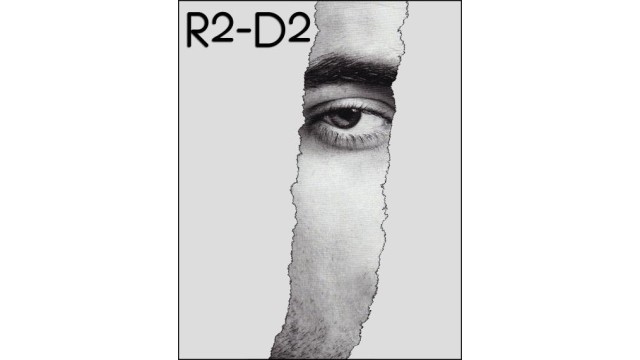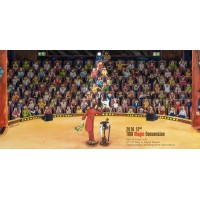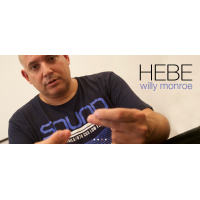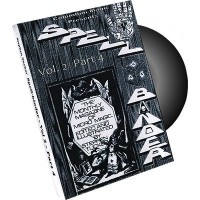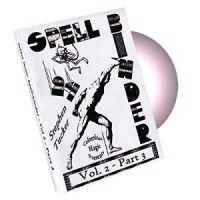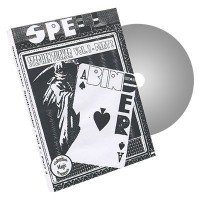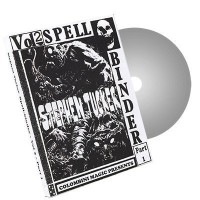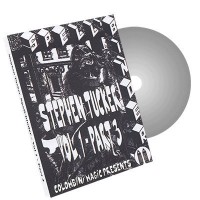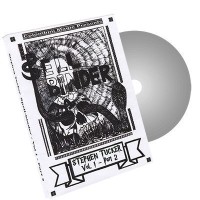R2D2 by Doug Dyment
- Product Code: T2300
- Reward Points: 25
- Availability: In Stock
- $10.98
-
$5.99
- Price in reward points: 599
Doug Dyment - R2D2
A Monograph on an Optimal
Billet Tear with 2 Real-Time Peeks
What can one say about billet tears that hasn't already been said? Do we really need another one? How many ways can there be to fold and tear a piece of paper? The answers just might surprise you!
R2-D2 embodies a truly original approach, not merely another variation on an old theme. A tear that has been engineered from the ground up to meet twentydemanding, objective criteria:
Twenty Billet Tear Evaluation Criteria
- The peek(s) must be optimized for execution in real time (i.e., during the tearing sequence).
- There must be no reliance on hidden actions: the tearing should be an open, transparent process, taking place at the fingertips, exactly as it appears, with no concealed openings or other moves.
- It must be possible to perform at least the first couple of tears (when onlooker scrutiny is most intense) with eyes fully averted.
- Each peek must be coincident with a specific tearing, to justify the eye movement.
- The tear must also accommodate those performers — and performing situations — requiring a delayed read (i.e., non-real-time, with the “hot” portion of the billet retained in the hand for later reading, under conditions yielding less scrutiny and/or further removed in time from any overt manipulation of the paper).
- It must be possible to view a substantial portion (at least half) of the original billet during the peek(s).
- Before the entertainer receives the billet, it must be folded at least twice, with intersecting folds, such that the writing seems safely concealed on the inside.
- The actual tearing process must be physically undemanding: a tear shall never encompass more than four thicknesses of paper, or begin at a folded edge.
- The actions must be effective when performed with dry fingers.
- The information to be read shall not require placement in an idiosyncratic fashion, but be centred on the vertical axis of the paper (when held in normal writing position).
- No illogical tears are permitted; they must always encompass the entire billet, and be down the middle of its shorter dimension (i.e., no lengthwise tears, partial tears, “off-centre” tears, etc.), exactly the way a person would normally tear a packet of paper.
- No illogical moves should be used (e.g., unnecessary turnovers, unexplained rotations, counting/“fiddling”/flipping of paper layers, finger insertions, etc.); nothing should appear in any way unusual.
- There shall be no requirement for “careful” folding (i.e., no stepped edges, skewed folds, overly precise alignments, etc.); everything should be casual and require no special attention.
- Repeated actions must appear consistent (i.e., tears must look identical, unfoldings must open in the same way, rotations must be in the same direction, etc.), the way that a normal person would do them.
- There should be no significantly “unbalanced” tears: each hand should grip approximately the same amount of paper during each tear.
- There shall be no writing orientation issues: the peek(s) should display the information in its original, upright position.
- The post-performance detritus may contain no unexpected shapes, disproportionate sizes, or any other evidence of trickery: the resulting pieces should be thoroughly examinable and unremarkable.
- Except for the moment and sightline of the actual peek(s), all billet actions should be clearly viewable from any direction, with no written portion of the billet exposed at any time.
- During the actual peek(s), no more than one quarter of the billet surface area should be exposed, to facilitate its concealment.
- No unduly special paper can be required, in size, shape, or composition (including grain orientation); it’s fine for the tear to be optimized for a particular type of billet, but it should still work when used with other types.
Fortunately, the R2-D2 billet tear is both easily learned and performed: given its many practical benefits, you’ll surprise yourself with just how “goof-proof” this actually is. If your current favourite method doesn’t measure up to these standards, why not consider this fresh, game-changing approach?
And the book offers much more than the methodology itself, with groundbreaking thinking contributed by some of mentalism’s busiest workers: new plot ideas, thoughts on justifying billet usage, and subtle strategies to elevate your game.
So if you’re intrigued by billet work, but have found existing methodologies to be complicated, convoluted, constraining, contorted, contrived, confusing, or simply less than compelling, you may well discover R2-D2 to be just what you’ve been searching for!
Reviews (0)
Related Products
Joe Rindfleisch Penguin Live Online Lecture
"Consistently creative, innovative, and remarkable work." - Dan Harlan “In rubber band..
$2.99 $5.99
Alain Nu Penguin Live Online Lecture
Alain Nu, “The Man Who Knows”, has performed all over the world, headlined at casinos in Las Vegas, ..
$2.99 $5.99
The Magic Book by Karl Fulves
Tight Binding, Limited Chipping or Tears to Edges, No Markings or Creasing, Covers are Slightly Scar..
$1.99 $4.99
Recommend
The Series Vol 1 Color Change by Cheng Lin
The Series Vol 1 Color Change by Cheng Lin As one of the most skilled underground magicians in New ..
$1.99 $4.48
At The Table Live Lecture The Other Brother
At the Table Live Lecture starring The Other Brothers You may not have heard of the Other Brothers...
$1.99 $4.99
At The Table Live Lecture Chris Brown
At the Table Live Lecture by Chris Brown Chris "Orbit" Brown, creator of countless moves, effects, ..
$1.99 $4.28
El Punto by Asi Wind
El Punto by Asi Wind Cl??sico efecto en las manos y en la versi??n del Neoyorkino Asi Wind. Una bel..
$1.99 $4.99
Pintare Al Centro by Yves Carbonier
Yves Carbonier - Pintare al centroBonita tecnica hecha efecto, que podras usar en muchas rutinas.06:..
$1.99 $4.99
Tinta Viajera by Xulio Merino
Xulio Merino - Tinta viajeraOtra inclreible ruitna de bolas de esponja de este gran mago...
$1.99 $4.99
Hebe Production by Willy Monroe
Willy Monroe - Hebe ProductionProduccion de billetes, de la loca mente de Willy Monroe, que podras u..
$1.99 $4.99
14 Mi Numero De La Suerte by Toni Montana
Toni Montana - 14 Mi numero de la suertedemo:https://www.youtube.com/watch?v=EXgz7vyMRZkEfecto de me..
$1.99 $4.48
The White Box by Thinking Paradox
Thinking Paradox - The White BoxFrom the Thinking Paradox team, creators of bestsellers BOND and CLE..
$1.99 $4.28
Spellbinder Dvd 2 - Part 4 by Stephen Tucker And Wild-Colombini Magic
Stephen Tucker and Wild-Colombini Magic - Spellbinder DVD 2 - Part 4Product DescriptionRoutines Perf..
$1.99 $4.68
Spellbinder Dvd 2 - Part 3 by Stephen Tucker And Wild-Colombini Magic
Stephen Tucker and Wild-Colombini Magic - Spellbinder DVD 2 - Part 3Product DescriptionROUTINES PERF..
$1.99 $4.68
Spellbinder Dvd 2 - Part 2 by Stephen Tucker And Wild-Colombini Magic
Stephen Tucker and Wild-Colombini Magic - Spellbinder DVD 2 - Part 2Product DescriptionSpell-binder ..
$1.99 $4.68
Spellbinder Dvd 2 - Part 1 by Stephen Tucker And Wild-Colombini Magic
Stephen Tucker and Wild-Colombini Magic - Spellbinder DVD 2 - Part 1Product DescriptionROUTINES PERF..
$1.99 $4.68
Spellbinder Dvd 1 - Part 3 by Stephen Tucker And Wild-Colombini Magic
Stephen Tucker and Wild-Colombini Magic - Spellbinder DVD 1 - Part 3Product DescriptionROUTINES PERF..
$1.99 $4.68
Spellbinder Dvd 1 - Part 2 by Stephen Tucker And Wild-Colombini Magic
Stephen Tucker and Wild-Colombini Magic - Spellbinder DVD 1 - Part 2Product DescriptionROUTINES PERF..
$1.99 $4.68

